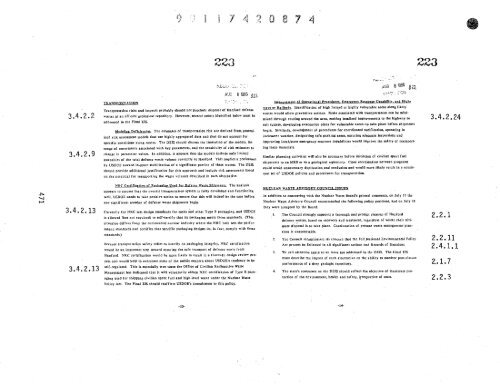EIS-0113_Section_11 - Hanford Site
EIS-0113_Section_11 - Hanford Site
EIS-0113_Section_11 - Hanford Site
Create successful ePaper yourself
Turn your PDF publications into a flip-book with our unique Google optimized e-Paper software.
f<br />
223<br />
kin 8 f98'D dZ^<br />
A75 81966 X72<br />
TRANSPORTATION - -<br />
Im ant I I Pr -<br />
3.4.2.2<br />
Traospormlion risks and impacts probably should are p letho ric disposal of <strong>Hanford</strong> defense<br />
wastes at an off-sit, geological repositor y. However, several points iden tified below must be<br />
addressed in the Final ENS.<br />
ar Be (beds. Identification of high hea rt ed or highly vulnerable ar ia s along likely<br />
tees would allow preventive actions. Risks associated with transportation can be miniround<br />
through routing around the arc., making I ... Iliud improvements a the highway or<br />
rail system, developing re cand.. plans far vulnerable areas—to take place before shipments<br />
3.4.2.24<br />
Modell., Deficiencies, The allima¢s of transportation risk in derived from , general<br />
bell.. Similarly, development of procedural far e000riented notifiellian, up ... in, in<br />
3.4.2.9<br />
sled risk assessment models that use highly ag g re g ated data and that do not account for<br />
specific conditions along routes. The D<strong>EIS</strong> should discuss Bar limi ta tion of the models, the<br />
range of uncertainty associated with key parameters, and the sensitivity of risk estimates to<br />
change in parame ter values. In addition, it appears that the models include only limited<br />
quantities of the total defense waste volame curfeot], at <strong>Hanford</strong>. This im It plies preference<br />
by USDOE toward Im,ho .stabilization of a significant portion of these wastes. The D<strong>EIS</strong><br />
should provide additional justification for this a pproach and include risk assessments based<br />
on the p oten ti al for transporting the waste volumes described in Su ch al¢mative.<br />
inclement weather, designating safe parking areas, ensuring ade q uate inspections and<br />
Improvin g local'smte emergency response ca pabilities would improve he safety of ttanspom<br />
ion the re materials<br />
Similar p lanning activities will also be necessary before initiation of civilian s pent fuel<br />
shipments to an MRS Or to a geological rcpository. Close coordination between programs<br />
could avoid unnecessary duplication and confusion and would more likely result in a rousisent<br />
nt of USDOE polici es and procedures for transportation<br />
V<br />
N<br />
3.4.2.13<br />
3.4.2.13<br />
R Hfle r Pa eke reed roe r rise N' Shl rte ts. The ... r Sis<br />
appears to assume that the overall transportation system is fully developed Suit<br />
well, USDOL seeds 10 take positive action to no ... a thee this will indeed be the ease before<br />
any significant number of defense waste shipments begin.<br />
Currentl y the NBC sets delta. standards for casks and other Type B packaging, and USDOE<br />
is allowed (but not required) to self-certify that its packaging meets those standards. (This<br />
situation differs from tho commercial nuclear industry where the NBC both sets the perfor<br />
mance Standards and certifies that s pecific packaging designs do, in fact, comply with those<br />
standards)<br />
Because trans p ortation safety relies an heavily an p ackagin g integrity, NRC certification<br />
would be an important atop toward assuring the safe transport of defense wane from<br />
<strong>Hanford</strong> NBC certification would be more likely to result in a thorough design review p ros<br />
aotl would h elp to overcome some of the public concern about USDO£s nume ric, to be<br />
self-regulated. This is especially trees aloe the Office of Civilian Radioactive Waste<br />
Wriagemem has indica ted that it will voluntarily obtain NBC certification of Ty pe R packaging<br />
used for shipping civilian spent fuel and high-le y el waste under the Nuclear Waste<br />
Policy Act. The Fire] <strong>EIS</strong> should traffic. USDOE's commitment to this policy.<br />
NUCLEAR N'AST£ ADVISORY CO tN IL ISSUES<br />
In addition to concurring with the Nuclear Waste Board's general comments, an July 1 7 the<br />
Nuclear Was te Advise,, Council rtcommerded the following p .tiny positions, sad oa July Ig<br />
they were accepted by the Board.<br />
1. The Council literary sup ports a thorough sad prompt des... of <strong>Hanford</strong><br />
defense wastes, based on recovery sad treatment, regardless of where their ultimate<br />
disposal is to take place. Continuation of present waste management pray<br />
[ices is unaceepmble,<br />
2. The Council reemphasizes its concern that the full National Environmental Policy<br />
Act process be followed in all significant actions and Records of Decisions.<br />
3. We call attention again to an issue not addressed in the D<strong>EIS</strong>. The Final <strong>EIS</strong><br />
oil describe the impact of each .Bemative on the abi liry t truth r P.<strong>11</strong>-domm<br />
performance of a deep g eolo g ic repository_<br />
4. The state's comments on the D<strong>EIS</strong> should reflect the objective of maximum pr o-<br />
Onchion of the environment, health and saf et y, ,respective of costs.<br />
2.2.1<br />
2.2.<strong>11</strong><br />
2.4.1.1<br />
2..1.7<br />
2.2.3<br />
M2<br />
a4-

















